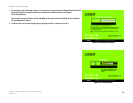
34
Appendix A: Troubleshooting
Frequently Asked Questions
Wireless-G Presentation Player
longer receives acknowledgment from its original Wireless Network Access Point, it undertakes a new search.
Upon finding a new Wireless Network Access Point, it then re-registers, and the communication process
continues.
What is a BSS ID?
A specific Ad-hoc LAN is called a Basic Service Set (BSS). Computers in a BSS must be configured with the same
BSS ID.
What is an ESS ID?
An Infrastructure configuration could also support roaming capability for mobile workers. More than one BSS can
be configured as an Extended Service Set (ESS). Users within an ESS could roam freely between BSSs while
maintaining a continuous connection to the wireless network stations and Wireless Network Access Points.
What is ISM band?
The FCC and their counterparts outside of the U.S. have set aside bandwidth for unlicensed use in the ISM
(Industrial, Scientific and Medical) band. Spectrum in the vicinity of 2.4 GHz, in particular, is being made available
worldwide. This presents a truly revolutionary opportunity to place convenient high speed wireless capabilities in
the hands of users around the globe.
What is Spread Spectrum?
Spread Spectrum technology is a wideband radio frequency technique developed by the military for use in
reliable, secure, mission-critical communications systems. It is designed to trade off bandwidth efficiency for
reliability, integrity, and security. In other words, more bandwidth is consumed than in the case of narrowband
transmission, but the trade-off produces a signal that is, in effect, louder and thus easier to detect, provided that
the receiver knows the parameters of the spread-spectrum signal being broadcast. If a receiver is not tuned to
the right frequency, a spread-spectrum signal looks like background noise. There are two main alternatives,
Direct Sequence Spread Spectrum (DSSS) and Frequency Hopping Spread Spectrum (FHSS).


















